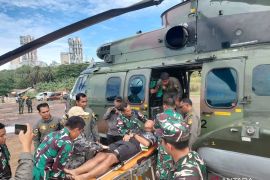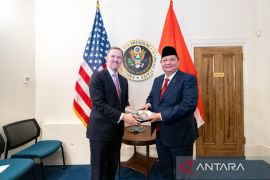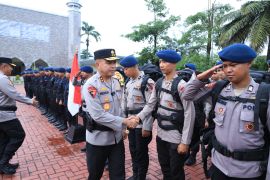Indonesia's most recent joint military training was with the United States during the 2024 Super Garuda Shield exercise, held in East Java from late August to September 2024. This was marked as the largest joint military exercise in the history of the Indonesian Armed Forces (TNI).
From November 4 to 8, the Indonesian Navy conducted another joint exercise with the Russian Navy in the Java Sea, East Java, as part of the 2024 Orruda Joint Training.
In 2021, the Russian Navy held a joint exercise with the naval forces of ASEAN countries, known as the 2021 ASEAN-Russia Naval Exercise (ARNEX-21). Indonesia hosted and co-chaired the event with the Russian Navy, covering the waters from North Sumatra to Sabang Island.
During ARNEX-21, Indonesia deployed its warship KRI Gusti Ngurah Rai-332 frigate, an AS-565 helicopter, a CN-235 aircraft, and 500 Navy personnel. Of the 11 participating countries, eight sent warships or aircraft, while three sent observers.
Russia has been one of ASEAN’s dialogue partners since 1996 and became a strategic partner in 2018. Russia is also a member of the ADMM-Plus Forum, a defense forum between ASEAN and eight other countries.
Russia aims to maintain its strong military cooperation with Indonesia, particularly given Indonesia's interest in acquiring Russian defense equipment, which has proven effective in modern combat.
The first joint exercise between Indonesia and Russia aligns with President Prabowo Subianto’s efforts to strengthen ties with Moscow. The Orruda joint exercise is a result of Prabowo's discussions with Russian President Vladimir Putin in Moscow in July 2024.
This exercise consisted of two phases: the Harbor Phase and the Sea Phase. The name "Orruda" combines two national symbols, the Russian eagle (Orel) and the Indonesian Garuda.
For the exercise, Russia deployed three corvette warships—RF Rezky, RF Gromky, and RF Aldar Tsydenzhapov—as well as the medium tanker Pechenga, a helicopter, and the Salvage Alata tugboat.
Meanwhile, the Indonesian Navy deployed two warships, KRI I Gusti Ngurah Rai-332 and KRI Frans Kaisiepo-368, along with a Panther AS565 anti-submarine helicopter.
Not a show-off contest
This exercise is not intended as a show of military strength, as Russia deployed only three corvette-class warships, a medium tanker, a military helicopter, and a tugboat.
However, compared to ARNEX-21, Russia has sent a greater number of warships this time, as it previously deployed only one destroyer-class vessel.
The cooperation between the combat forces of these two countries serves as a foundation for future collaborative operations, potentially including real operations aimed at maintaining world peace.
Russian Ambassador to Indonesia Sergey Tolchenov emphasized that the exercise was not meant to project strength but rather to enhance the capabilities and potential of Russia's naval forces.
Some observers expressed hope that Russia would display its primary naval weaponry in this exercise, providing a reference for Indonesia as it seeks to bolster its naval combat capabilities.
One area of focus for future development is the radar and electronic warfare systems of the Russian Navy, which could inform efforts to strengthen the Indonesian Navy's capabilities.
Sophisticated missiles
The increasing speed of ballistic missiles is making them more difficult to intercept with anti-missile weapons. Therefore, a more advanced warship endurance system is needed, including support for defense satellites. The missile threat to modern warships has evolved significantly in recent decades.
Anti-ship cruise missiles (ASCM) have advanced considerably, leading to the development of anti-ship ballistic missiles (ASBM). China has demonstrated this evolution with its production of the DF-21D, DF-26, and YJ-21 missiles.
The DF-21D is the world’s first ASBM, capable of operating at a range of up to two thousand kilometers and carrying explosives powerful enough to sink aircraft carriers.
Additionally, the missile threat to modern warships has intensified with the advent of hypersonic missiles, including hypersonic glide vehicles (HGV) such as the Chinese DF-17 and hypersonic cruise missiles (HCM) like the Russian 3M22 Zircon.
Hypersonic weapons travel at speeds exceeding Mach 5, reducing the response time of onboard air and missile defense systems to under 40 seconds.
These weapons pose a significant threat to aircraft carriers, not only due to their large target area and the potential material losses, but also because of the severe psychological impact their destruction could have during wartime.
In light of these developments, the 2024 Orruda Joint Training is expected to accelerate the Indonesian Navy’s modernization efforts.
During defense talks between Russian and Indonesian military leaders in Surabaya, discussions are expected to cover new tactical weapons systems and joint maritime patrol operations.
Vice Admiral Denih Hendrata, Commander of the Indonesian Fleet, stated at the event's opening that this joint exercise had been planned in advance and marked the first joint exercise between Indonesia and Russia.
The exercise aims to strengthen Indonesia-Russia diplomatic ties and provide insights into the advanced warfare technology developed by the Russian Navy.
This joint exercise is seen as an important step for Indonesia to protect its territory and test the Navy's readiness against external threats.
On October 24, 2024, while receiving a courtesy visit from Chinese Ambassador to Indonesia Wang Lutong, Indonesian Defense Minister Sjafrie Sjamsoeddin also expressed his eagerness to enhance defense cooperation, particularly through joint exercises with China.
Related news: Four Russian warships dock in Surabaya for Orruda Joint Training
Related news: SIM-367 warship conducts training before departing for Lebanon
Translator: Budhi Santoso, Resinta Sulistiyandari
Editor: Anton Santoso
Copyright © ANTARA 2024












